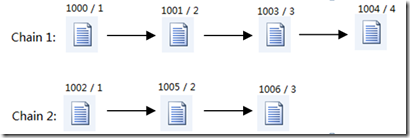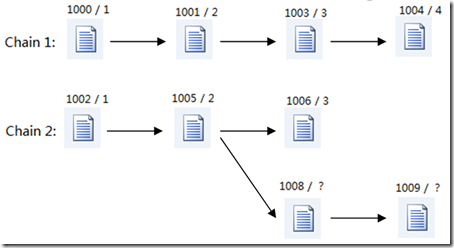最近一个朋友接手了一个项目,为自己部门开发文档版本管理系统。我在和他闲聊中,听他说起数据表设计时遇到的一个疑惑。听他说完后感觉这样的问题还是有一些普遍性的,在这里进行一下分享。
问题描述
文档版本管理最主要的是要维护文档的版本链。这很容易让人想到链表这种数据结构,所以我的那位朋友很快就给出了如下的表结构:
1 |
create
table
Table_Docunment |
3 |
Docunment_Id
int not
null
identity(1000, 1) primary
key,
|
4 |
Docunment_Name
nvarchar(64) not
null,
|
5 |
Docunment_SubmitDate
datetime not
null,
|
6 |
Docunment_PreId
int not
null default(-1),
|
7 |
Docunment_NxtId
int not
null default(-1),
|
其中Docunment_PreId存放前一版本文档的Id,Docunment_NxtId存放下一版本文档的Id。
起初还没有感觉出什么问题,但当他试图向Table_Docunment填充测试数据或试图写一个存储过程来获取其链上最新的文档时,感觉非常痛苦。
在他的存储过程中需要进行循环,他自己知道这样性能不好,但又不清楚如何解决。
解决方案
问题的关键在于初始的设计并不适合系统的使用场景。原始的设计导致了取某文档的下一版本或上一版本都需要进行连接(Join)操作,若要获得最新版本文档,还需要进行循环。
对原始设计进行修改,新的表结构如下(省略了部分字段):
1 |
create
table
Table_Docunment |
3 |
Docunment_Id
int not
null
identity(1000, 1) primary
key,
|
4 |
Docunment_Name
nvarchar(64) not
null,
|
5 |
Docunment_ChainId
int not
null default(-1),
|
6 |
Docunment_VersionId
int not
null default(-1),
|
7 |
Docunment_SubmitDate
datetime not
null,
|
其中Docunment_ChainId为当前文档所属的版本链,Docunment_VersionId为当前文档在版本链中的版本号(从1开始的连续编号)。
在列(Docunment_ChainId, Docunment_VersionId)上可加unique约束。
举例来说,有如下两条文档链:

(图1)
其中文档上方的两个数字分别代表文档编号(Docunment_Id)和版本编号(Docunment_VersionId)。把这些信息存储到新的Table_Docunment中,结果如下:
| Docunment_Id |
Docunment_Name |
Docunment_ChainId |
Docunment_VersionId |
Docunment_SubmitDate |
…… |
| 1000 |
aaa |
1 |
1 |
2010-01-01 12:03:00 |
…… |
| 1001 |
bbb |
1 |
2 |
2010-01-02 06:02:00 |
…… |
| 1002 |
ccc |
2 |
1 |
…… |
…… |
| 1003 |
…… |
1 |
3 |
…… |
…… |
| 1004 |
…… |
1 |
4 |
…… |
…… |
| 1005 |
…… |
2 |
2 |
…… |
…… |
| 1006 |
…… |
2 |
3 |
…… |
…… |
对于给定的一个文档,要找其上一版本或下一版本的文档时,只要找其同一条链上版本号小1或大1的文档。若要找最新版本文档只要在链上对版本号取max就行了,也很方便。
新的需求
这样的设计已基本满足我那位朋友的需求了,但在某些使用场景下,情况可能会更复杂些。
若文档链有文档归并的情况,即两个文档链的最新文档版本是同一个文档,示意图如下:

(图2)
对于这个新的需求,先前的设计就会有一些问题,对于图中文档1007,其版本号对于链1应为5,对于链2应为4,实在是没办法填,我先用了一个问号。
新的需求改变了链和文档之间的关系。原先链和文档之间为1对多关系(注:标准情况下1对多关系会有两张表,但由于链在此系统中是一个虚概念,而且链实体也只会包含一个Id列,所以在先前设计中省去),现在链和文档之间变为多对多关系。多对多关系需要3张表,两个实体表,一个关系表。在此系统中链的实体表可以省去,所以我们只要引入一张关系表。
重构原先设计,脚本如下:
01 |
create
table
Table_Docunment |
03 |
Docunment_Id
int not
null
identity(1000, 1) primary
key,
|
04 |
Docunment_Name
nvarchar(64) not
null,
|
08 |
create
table
Table_DocChain |
10 |
DocChain_ChainId
int not
null,
|
11 |
DocChain_VersionId
int not
null default(1)
check(DocChain_VersionId
>= 1), |
12 |
Docunment_Id
int not
null references
Table_Docunment(Docunment_Id),
|
13 |
DocChain_SubmitDate
datetime not
null,
|
14 |
primary
key(DocChain_ChainId,
DocChain_VersionId) |
主要是添加了Table_DocChain这张关系表,对于我在此表上加的约束大家可以自己思考。
检验一下重构后的设计,把图2中的信息存入新的表结构中。
Table_Docunment:
| Docunment_Id |
Docunment_Name |
…… |
| 1000 |
aaa |
…… |
| 1001 |
bbb |
…… |
| 1002 |
ccc |
…… |
| 1003 |
…… |
…… |
| 1004 |
…… |
…… |
| 1005 |
…… |
…… |
| 1006 |
…… |
…… |
| 1007 |
…… |
…… |
Table_DocChain:
| DocChain_ChainId |
DocChain_VersionId |
Docunment_Id |
DocChain_SubmitDate |
| 1 |
1 |
1000 |
2010-01-01 12:03:00 |
| 1 |
2 |
1001 |
2010-01-02 06:02:00 |
| 2 |
1 |
1002 |
…… |
| 1 |
3 |
1003 |
…… |
| 1 |
4 |
1004 |
…… |
| 1 |
5 |
1007 |
…… |
| 2 |
2 |
1005 |
…… |
| 2 |
3 |
1006 |
…… |
| 2 |
4 |
1007 |
…… |
其中关键的两行记录已用粗体标出。
反过来思考
前一节讨论了文档归并的情况。有文档归并,就有可能出现文档分支,那该如何处理呢?是否需要修改设计?
我们先看一下文档分支的示意图:

(图3)
文档分支没有改变链和文档之间的关系,所以我自己觉得前面的表结构设计不需要修改。
那图3中分支链上的问号处如何填呢?
当文档进行分支时,其已经不归属于原先的链了,应新创建一条链。图3中,当文档1005分支时,在表Table_DocChain中应插入一条DocChain_ChainId:3,
DocChain_VersionId: 1, Docunment_Id: 1005的记录,此分支的随后文档都归属此新链,这样问题就解决了。
防止文档链成环
对于文档链的一个重要约束是不能成环。这个约束可以在应用程序端实现,但数据库端的检查永远是我们最后的一道防线。我们应尽可能通过约束或其他手段来避免错误数据进入数据库。
如果能用check约束来避免链成环是最为直接的,在Table_DocChain中加如下约束:
01 |
alter
table
Table_DocChain |
02 |
add
constraint
CK_LoopChain |
11 |
DC1.DocChain_ChainId
= DC2.DocChain_ChainId |
13 |
DC1.DocChain_VersionId
<> DC2.DocChain_VersionId |
15 |
DC1.Docunment_Id
= DC2.Docunment_Id |
其逻辑是在同一条链中,不存在版本号不同,且文档号相同的记录。
但非常可惜无论在SQL Server 2008还是Oracle中,check约束都不允许使用子查询(Subqueries)。
我们可以通过带有with check option的视图来达到目的,代码如下:
01 |
create
view
View_DocChain |
05 |
DC1.DocChain_VersionId,
|
07 |
DC1.DocChain_SubmitDate
|
17 |
DC1.DocChain_ChainId
= DC2.DocChain_ChainId |
19 |
DC1.DocChain_VersionId
<> DC2.DocChain_VersionId |
21 |
DC1.Docunment_Id
= DC2.Docunment_Id |
对于Table_DocChain的插入、修改,都通过View_DocChain来进行,就能防止文档链成环的发生。
| 

